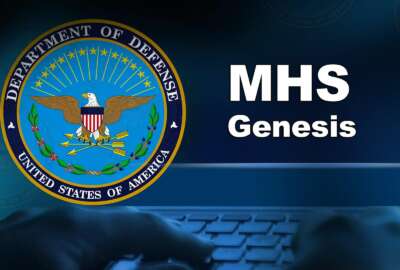

Federal Electronic Health Record Modernization (FEHRM) program office will be a single point of accountability for EHR modernization, the Defense Department and...
Best listening experience is on Chrome, Firefox or Safari. Subscribe to Federal Drive’s daily audio interviews on Apple Podcasts or PodcastOne.
The departments of Defense and Veterans Affairs said they’ve finally settled on a joint management structure to make sure the multibillion-dollar electronic health record systems they’re buying are integrated and interoperable.
But some members of Congress say it’s too little too late, and advanced legislation meant to force more cooperation between the two departments.
For a decade, DoD and VA have had an Interagency Program Office (IPO) in place to handle EHR matters. But its role and authorities have become murky, and lawmakers say it hasn’t been serving as the single point of accountability required by current law.

So DoD and VA officials said they’re re-chartering the IPO and giving it a new name: The Federal Electronic Health Record Modernization (FEHRM) Program Office. They said it will have a significant amount of decision-making authority to make sure the rollout plans for the two EHRs are synchronized as DoD and VA deploy them over the next decade. The office will report directly to the deputy secretaries of each department.
“The FEHRM will provide a comprehensive, agile and coordinated management authority to execute requirements necessary for a single, seamless, integrated EHR and will serve as a single point of authority for the departments’ EHR modernization programs,” Lauren Thompson, the director of the current IPO, told the House Veterans Affairs Committee this week. “It will have the authority to direct each department to execute joint decisions for technical, programmatic and functional matters under its purview, and will provide oversight regarding required funding and policy as necessary.”
But the departments still have not told Congress exactly which types of decisions will fall within the new organization’s purview. And while Congressional overseers have long pressed for a more empowered joint management structure, they say they still don’t have enough information to know whether this particular one will work.
“Lack of cooperation has been the graveyard of all of the previous [EHR integration] efforts,” said Rep. Jim Banks (R-Ind.), the ranking member of the House VA technology modernization subcommittee. “Case in point: you have spent much of the last nine months hammering out a joint management structure. I want to support your decisions, but it is not reasonable to expect this subcommittee to endorse decisions that we have scant details about — decisions that are the product of a secretive process. I understand the desire to make the agreement in private before disclosing anything. The problem is though there has been no agreement. Compromise has been elusive because the stakes were so high, and both sides were apparently dug in so deeply.”
On Wednesday night, the House Armed Services Committee, as part of its markup of the annual defense authorization bill, approved a measure Banks sponsored that would attempt to clarify at least some aspects.
Among other things, it would require that the director and the deputy director of the FEHRM Program Office be jointly appointed by both the secretary of Defense and the secretary of Veterans Affairs. Both of the new leaders would need to have significant experience as clinicians, and they’d need to have already led large-scale health IT implementation projects.



John Windom, the executive director of VA’s Office of Electronic Health Record Modernization, said the phased approach is “imperative.”
“It’s not to delay, but it is to support the proper, efficient, and timely movement of resources into the FEHRM to support their decision making process without compromising the risk in our present portfolios,” he said. “The second phase would be in support of solidifying workflows and alignment with DoD in that arena. The third phase would revolve around a critical milestone called initial operating capabilities. Until we demonstrate that it works in an operational environment, it really does not make sense to move resources, and it’s the end users that will solidify our success. Taking those end users into consideration is what has driven our three phase strategy.”
But DoD and VA officials were unwilling to commit to a timeline for when they might be able to offer Congress more details on their plans.
As of now, lawmakers say they’re in the dark about the new organization’s charter, or even how much time the three-phase plan will take to pull off.
Rep. Susie Lee (D-Nev.), the chairwoman of the technology modernization subcommittee, said the departments haven’t provided much more than a few PowerPoint slides.
“It’s hard to find where the governance and accountability is in this plan. We also are missing details about staffing and resources,” she said. “Based on the timeline for implementation, it appears that it will come too late to address the critical decisions that must be made. And I wonder whether the DoD and VA are invested in the idea of true joint governance and transparency, since both declined to provide feedback on a potential legislative solution to finally create a single accountable joint governance office. I hope I’m wrong, and that they do want a real solution and a functional governance structure.”
But legislative leaders point out that many of the key decisions — particularly the monetary and contractual ones — have already been made. All told, the two departments plan to spend at least $16 billion to implement versions of Cerner’s Millennium health record across their health care enterprises.
DoD has already deployed its version of the system, called MHS Genesis, at four pilot sites in the Pacific Northwest, and additional rollouts are planned at facilities in California and Idaho this September. VA, meanwhile, intends to start introducing its variant of the Cerner product at hospitals and clinics the Pacific Northwest next year.
But officials insisted they’ve already gone a long way toward joint decision making, even without a formal governance office in place.
“Cybersecurity is one area of extensive collaboration and joint decision making,” said William Tinston, the Program Executive Officer for Defense Healthcare Management Systems. “DoD sets the standard for cybersecurity and we invest time and resources to ensure the common system meets that standard. We also work closely with our VA partners to ensure we maintain system integrity. Recommendations for system enhancements are carefully evaluated by our joint work groups to minimize program risks and impacts … we are making daily strides and the implementation of an enterprise solution that will not only advance care for our beneficiary and veteran communities, but will ultimately lead to a longitudinal record focused on the patient, not where care is delivered.”
Copyright © 2025 Federal News Network. All rights reserved. This website is not intended for users located within the European Economic Area.
Jared Serbu is deputy editor of Federal News Network and reports on the Defense Department’s contracting, legislative, workforce and IT issues.
Follow @jserbuWFED
